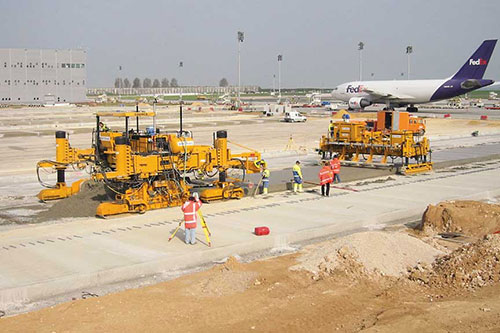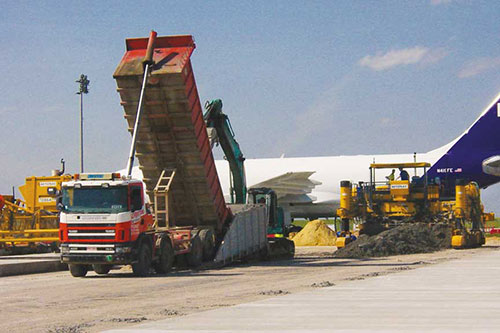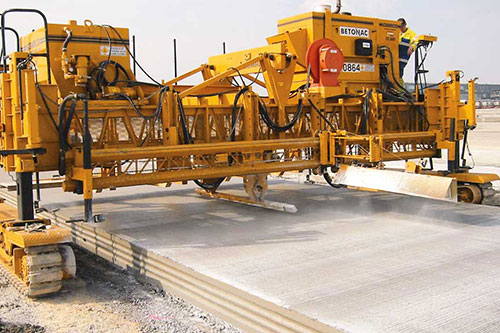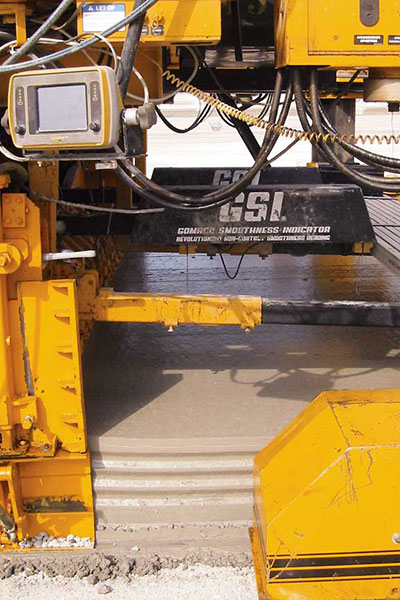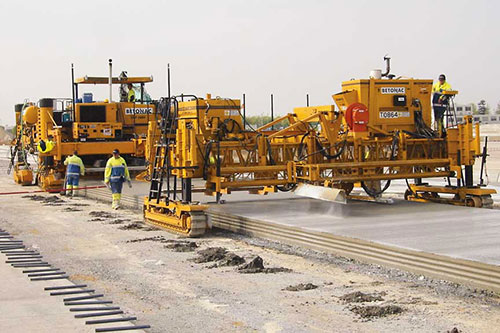GOMACO World Index --- GOMACO World 35.2 - July 2007
34 Paving Passes for a GHP-2800 at the Charles de Gaulle International Airport
Betonac nv in Sint-Truiden, Belgium, has always been concerned about producing quality slipformed concrete. It’s a source of company pride and something they work very hard at. They’ve implemented the use of several features to help maintain quality, including slipforming with GOMACO pavers, operating their own concrete batch plant, and using a paver-mounted GOMACO Smoothness Indicator® (GSI).
All of these features, combined with a knowledgeable crew, have given Betonac an edge on their slipforming projects. They recently left their home country to take on their first project abroad at the Charles de Gaulle International Airport near Roissy, France, 25 km (15.5 mi) northeast of Paris.
They slipformed 44,000 m2 (52,625 yd2) of concrete apron for a new parking lot for FedEx® freight planes to load and unload. They were also responsible for slipforming a transitional concrete slab between the new apron and an existing roadway.
Restrictions for working at the international airport, the second busiest in terms of both passenger traffic and cargo traffic in Europe, were very tight. Decisions had to be made about what equipment and what personnel would be working on the site. Applications had to be filled out and turned in before work began and no substitutions throughout the course of the project would be allowed.
“Everyone who worked on the job site had to show a badge and we had a limited number of badges at our disposal,” Felix Boulez, Betonac’s CEO, explained. “The choice of who would apply for one had to be made very cautiously. The same was true for our vehicles. A regular group of staff and equipment would work from the beginning to the end of the job without any possibility of change, not even for employee illness or equipment breakdowns.”
They knew their four-track GOMACO GHP-2800 paver was up to the challenge and it was added to their equipment list. They also included their four-track Commander III to pave the transitional slabs and a GOMACO T/C-600 texture/cure machine.
Their GHP-2800 is equipped with the Leica stringless guidance system, Minnich Auto Vibe III smart vibrator monitoring system, a GOMACO Auto-Float® and a paver-mounted GSI. All are features that help Betonac slipform the best pavement possible.
The new apron is approximately 300 meters (984 ft) long, 170 meters (558 ft) wide and 400 mm (15.7 in) thick. It was slipformed in 34 passes with the GHP-2800 paving five meters (16.4 ft) wide.
Concrete was supplied by Betonac’s own batch plant capable of producing 120 m3 (157 yd3) of concrete per hour. The mix design was a standard paving mix with air entrainment and plasticizer added. Slump averaged 20 mm (0.79 in).
“The design of the concrete is important and influences our ability to get a smooth finish,” Boulez said. “It should be homogeneous during the whole job so we don’t have to make any changes to the slipform paver. That is why Betonac prefers to produce our own concrete.”
Trucks each carrying 12 m3 (15.7 yd3) loads of concrete transported the material to the paver. The trucks dumped into a holding container and an excavator placed the concrete in front of the GHP-2800.
Production averaged 100 m3 (131 yd3) per hour or 1200 m3 (1570 yd3) during a 12 hour paving shift.
“We worked under the capacity of the plant, because we wanted to be able to pave continuously,” Boulez explained. “Paving speed influences smoothness and is very important. It has to be tuned to the supply of concrete. A speed has to be found that ensures the supply does not get too far ahead of the paver, but also allows the paver to slipform constantly, without starting and stopping.”
The Auto Vibe III system on their GHP-2800 allows them to constantly monitor the vibrators’ output. It is another one of Betonac’s quality controls and the system pinpoints any vibrator that is not working properly. The system also monitors and controls all vibrator functions.
Betonac has also left stringline behind on all of their major projects and has been paving exclusively with the Leica stringless system for over three years now.
“With the stringless system, we know that every meter is as the project should be,” Boulez said. “With the 3D system, we need less space beside the paver because we don’t need to allow extra room for the stringline, we have immediate control behind the paver, and we have greater accuracy and precision.”
The Leica stringless system also has a mixed-mode paving configuration. It is especially helpful on airport projects where contractors are paving pilot lanes. For example, if a contractor is paving five lanes total, all adjacent to each other, typically they would pave lane #1, #3, then #5, leaving the gaps for lanes #2 and #4 to be filled in later. There has to be a smooth joint between the connecting lanes. The 3D mixed-mode paving feature allows the machine to be steered without having to set up any temporary stringline for the fill-in lanes. They can lock the paver to grade with the track legs to perfectly match the grade of the adjacent slabs.
“The mixed-mode paving feature is indispensable,” Boulez said. “A primary strip is measured and this data is given to our study agency to make a draft of the adjacent strip. Often it was a strip adjacent to an existing strip on one side and free on the other side. In this situation, the mixed mode is indispensable to achieve a good result and was very useful at the airport.”
Betonac uses three total stations in their stringless paving process. Two of them are constantly tracking and measuring the prisms on the paver. A third total station is used to conduct as-built checks behind the paver. The checks, which are conducted every five meters (16.4 ft), measure the line and level of the new concrete apron and provide instant feedback on the accuracy of the new slab.
Betonac is always concerned about paving the best project possible and looking for ways to improve the paving processes. They have been using a paver-mounted GSI on their GHP-2800 since 2003. It provides them with a constant indication of their pavement quality and instantly alerts them to any potential problems.
“We wanted a GSI to help us obtain maximum quality and to do that, we have to have a control on the smoothness during paving,” Boulez explained. “The GSI, with its bump alarm, alerts the operator when something is wrong. Everything can then be checked... the vibrators, the Leica system, any external factors that can disturb the work, and we can fix the problem. It gives us the ability to immediately react when there is an irregularity and gives us a chance to fix the problem with the Auto-Float or we can manually touch up the surface.
“We chose the paver-mounted GSI because we first wanted to learn the system, which went very well, before buying an extra machine. The GHP-2800 also has a stable frame to mount the GSI. Immediately after the mold, there is a control and an indication whether something went wrong and the concrete can be reworked right away.”
The apron specifications included three meter (9.8 ft) wide by three meter (9.8 ft) square recesses that will eventually become fuel pits. Betonac had to create a way to slipform over the pits, without filling them full of concrete. They built a metal formwork that could be placed in each of the pits. It was filled with sand and covered with plywood. The GHP-2800 could simply pave over the top of the fuel pit, finishers could finish around the structure, and later, when the concrete had hardened, the formwork was removed.
The edge of each of the apron paving passes had an intricate keyway built into it. The sinusoidal (wavy or curvy) joint was necessary on the airport to help transfer the weight of the cargo planes from one section of apron to the next. The keyway is accomplished in the slipforming process with a special sideplate extension that has the configuration built into it.
Dowel bars were also hand-drilled and inserted every 305 mm (12 in) into the edge of the longitudinal joint. Longitudinal and transverse joints are every five meters (16.4 ft).
A GOMACO T/C-600 texture/cure machine followed the paver applying a transverse tine and a water-based transparent curing compound. Betonac’s T/C-600 is equipped with a transverse curing mechanism, which allows them to cure and tine simultaneously in a single pass. In the absence of stringline, the T/C-600 is sensored off the slab. The operator manually steers while the sensor controls the level of the machine.
The transitional slab was paved with Betonac’s four-track Commander III. The strip was 1200 mm (47.2 in) wide and had a variable thickness. It was 350 mm (13.8 in) thick tying into the concrete apron and tapered down to 150 mm (5.9 in) thick against the existing roadway.
“This was our first project abroad and it was our first airport project of this size,” Boulez said. “Quality is very important to us and because we have the Auto Vibe III, GSI, stringless system and GOMACO equipment, we have complete quality control and everything under our own management. We are looking forward to completing more projects like this at home and abroad.”
Their work is now complete on the parking apron and Betonac is gearing up for their next project at the airport. They’ll be slipforming a 145,000 m2 (173,424 yd2) concrete apron for the Aeroport de Paris’ new terminal project.
Subscribe to Receive GOMACO World Magazine
